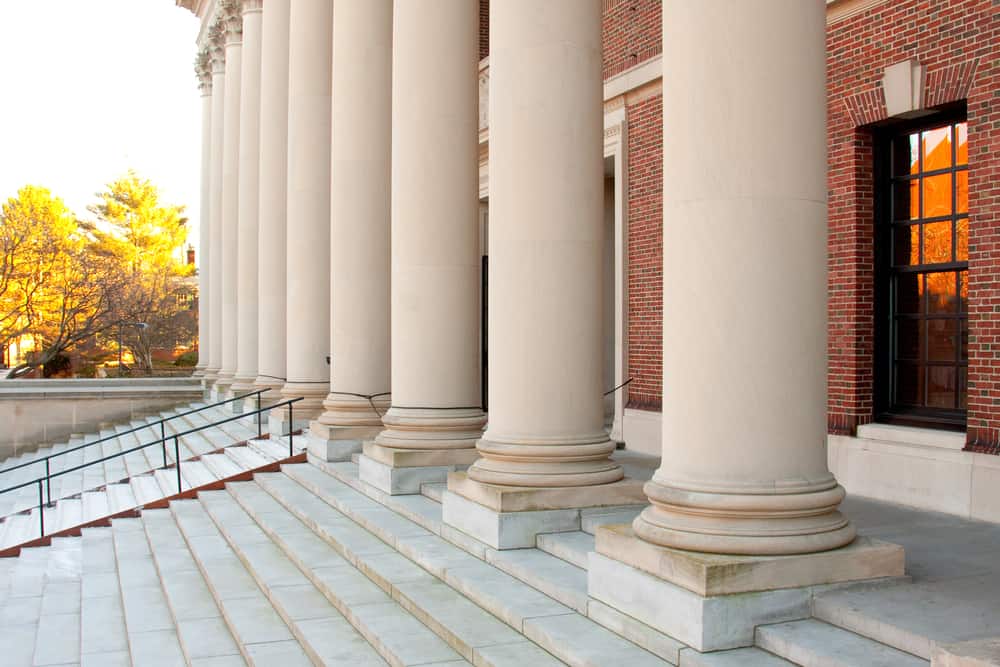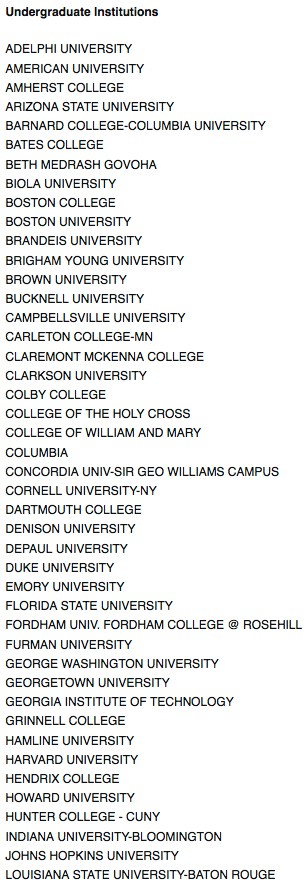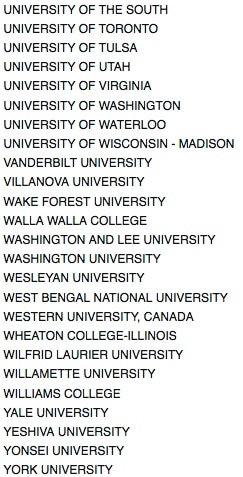
Today I’m passing along an interesting list that I pulled from the website of Harvard’s law school.
The list that you see below includes the 161 colleges and universities where members of the law school’s Class of 2015 received their bachelor’s degrees.
Harvard’s law school accepted 865 applicants out of a pool of 5,438 for an acceptance rate of 15.9%. With 557 students accepting a first-year spot, no individual undergraduate institution could dominate as a feeder institution.
On the list you’ll see that some of the law school students graduated from elite institutions, but there were plenty of successful applicants from schools that most Americans probably have never heard of including Biola University, Hamline University, Missouri Valley College, Norwich University and Walla Walla College.
You’ll appreciate why I’m sharing this list if you scroll all the way down to bottom.
Bottom Line:
This Harvard list reminded me of a conversation that I had at a college conference a year ago with a UCLA admission representative. She said that undergrads at her elite state university often assume that they will enjoy an advantage getting into the professional schools at their alma mater, but it isn’t true.
When I mentioned the wide net that Harvard Law throws for its classes, the admission rep said that the same phenomenon happens on her campus. The list of accepted students at the medical school, for instance, will include great candidates from schools that aren’t on any dream-college lists.
As I’ve emphasized repeatedly on this college blog, where you attend college isn’t nearly as important as what you do when you get there. Just ask the admission folks at UCLA and Harvard.
Lynn O’Shaughnessy is the author of The College Solution: A Guide for Everyone Looking for the Right School at the Right Price.





Thanks for the article. This is encouraging to see that elite professional programs are accepting students from a vast array of colleges, not just the elite undergrad programs. However, as stated above, we would need to see the number of students accepted from each school to see if they truly don’t judge a student based on their undergraduate college.
It would also be interesting to see what the different undergrad college majors were of the students that got accepted. Some say that elite professional programs place too much emphasis on grades and extracurricular involvement. Would Harvard Law rather accept a Theater major with a 4.0 GPA and president of a club or an Electrical Engineering major with a 3.5 GPA? That is taking nothing away from Theater majors but I would just be curious to see what emphasis Harvard Law places on the difficulty of the undergrad program.
I think the real question is what did this 800-odd applicants have that the rest of the 5438 didn’t? What made them stand out from the rest? We can probably assume that the vast majority of the 5438 were all top students — there probably weren’t 865 A+ students and the rest D’s. Likewise, and perhaps more revealing, what were the schools those who failed to get in came from? Probably much the same list with a few others added.
I agree that “fit” is one of the most important things. Without it, a student may not meet their potential. But as a parent, my fear is fit alone isn’t enough and we also need to include the probabilities in the calculation.
JanetM you are correct that a histogram may tell another story. But I agree with Lynn that too many parents are concerned about playing statistical games instead of finding the correct fit for their child. (And I have a MBA in Statistics!)
My daughter, Natalie, went to Hamline University, which is mentioned in the article. Hamline is an example of a regional, small, liberal arts college that is communal in nature, that I advocate for young women. When she enrolled at Hamline, she had no idea that she was going to get a Master of Social Work. While at Hamline, Natalie worked hard, started a club, received the lead in a play (even though she was not a drama major),got to know her professors and fellow students. When she applied to Washington University which is tied for the #1 graduate social work program with University of Michigan – Ann Arbor by US News, she was not only accepted but received a major scholarship. I doubt any other student from Hamline was in her class at Washington University. But she flourished at Hamline, which led to her admittance to a top graduate school.
What a great story Chuck.
When families are looking for colleges, I think they too often overlook whether a child will be able to thrive at an institution. This goes way beyond trying to beat the odds of getting into the most prestigious place possible.
Being a big fish in a small pond definitely has its advantages. That certainly was the case with my daughter Caitlin who attended Juniata College. She squeezed the absolute most out of that school and in the process really stood out. She got an excellent job at a small toy company after graduating and returning back home to San Diego. She just got a large raise at her company and is now the marketing manager just two years out of school.
Lynn O’Shaughnessy
A histogram showing how many of those 865 students went to each of those 161 schools is sorely needed, yet it’s doubtful Harvard would ever release that info.
If 161 undergrad schools had kids get in, and 140 of those got just 1 person in, while the top 20 of those schools got in several dozen each, it would make this article still very interesting, but with the exact opposite point as the article implies.
Easier to keep the rejection rate up without that histogram.
Lynn, you can’t post enough of this type of information! Another thing to remember is that when your child is looking for a job, the employer is going to be most interested in the last institution that they graduated from— so where you go to grad school is actually more important than where you do your undergrad. So save your money on your child’s undergrad education, and then you will be able to help them go to the best possible graduate/professional school, where they can take advantage of that school’s placement services, alumni network, etc.